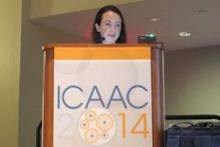WASHINGTON – Two studies of men having sex with men suggest that hepatitis C transmission in that group might be on the cusp of a big increase, in part because of risky behavior such as unprotected anal intercourse and injection drug use.
One study was conducted among MSM in Switzerland, while another was a retrospective look at HIV-negative men in several sexual health clinics across London.
In the Swiss study, researchers wanted to assess knowledge of HCV in MSM and also the prevalence of HCV in a local population. Regular screening for HCV in the MSM population was recommended by the European AIDS Clinical Society in June, but actual screening and knowledge is thought to be low, said Dr. Matthias Cavassini of Lausanne (Switzerland) Hospital.
He and his colleagues approached 918 MSM from June 2011 to August 2012 and asked them to participate in an anonymous questionnaire and, subsequently, to undergo HCV testing. Seventy-one percent – 654 – agreed. The vast majority who agreed – 82% – had been approached at a clinic for MSM that screens for sexually transmitted illnesses. The rest came from a sauna (13%), sex clubs (3.2%), a gay pride event (1.4%), and parks (0.3%).
The median age was 33; 512 identified as homosexual (78%) and 140 as bisexual (21%). Most (431) were HIV negative, although 62 preferred not to disclose HIV status. The median number of sexual partners was 5; the range was 0 to 400. Fifty-two percent (337) had a history of STI screening within the past year. When asked about HCV screening, 154 said they’d been tested, while 380 (58%) said they did not know.
Fifty-five percent (357) had unprotected anal intercourse – a primary HCV risk factor – in the past year. Thirty-three percent (219) had a history of drug use or were current users, but only four (0.6%) reported injection drug use.
Half had no knowledge about HCV. Of the 302 who did report knowledge, a striking 84% said they were aware that HCV could be transmitted through anal sex. Only 26% knew that it could not be transmitted through oral sex. There seemed to be no particular factor that predicted knowledge.
Of the 654 who consented to HCV screening, only one (0.15%) tested positive, said Dr. Cavassini. The man’s primary risk factor was unprotected anal intercourse in the previous year.
One case does not make an epidemic, but the high prevalence of unprotected anal intercourse argues for screening in the MSM population, he said. "Is this an accident waiting to happen?" asked Dr. Cavassini.
The British study was conducted by Dr. Katie McFaul and her colleagues at Chelsea and Westminster Hospital. They retrospectively reviewed charts for all HIV-negative MSM at three clinics between Jan. 2010 and May 2014, and identified just 44 who met the criteria for acute HCV.
Of those, 15 had a previous negative HCV test within the past year, 11 had significant ALT elevation, and 18 were clinically diagnosed with HCV from risk exposure, history, and symptoms. The median age was 37, and the median number of partners was 2, with a range of 1 to 100.
Looking more closely at behavior, Dr. McFaul found that 82% reported that they engaged in unprotected anal intercourse. Many also engaged in equally risky behavior, including group sex (28%), fisting (25%), or using drugs during sex, with about 20% of those reporting injection drug use.
Of the 44 with HCV, 29 knew the status of their partner or partners; 2 had a partner with HCV, 13 had a partner with HIV, and 6 had a partner with HIV and HCV. Thirteen had an STI at the time of HCV diagnosis.
Eight had received postexposure prophylaxis for HIV before their HCV diagnosis. Overall, 15 of the 44 had a spontaneous clearance of the HCV. Eleven received treatment. Eleven percent were lost to follow-up and 30% are being observed.
While HCV prevalence seemed low, it is likely not accurate, said Dr. McFaul, noting that she and her colleagues found that HCV screening in HIV-negative MSM was rarely conducted. A one-month snapshot at the three clinics found that 15% (565) of 3,811 HIV negative men who came for sexual health screening were tested.
Extrapolating the data to all 623,350 visits during the 2010-2014 study period, Dr. McFaul estimated that about 261,036 HIV-negative MSM visited. At the current 15% screening rate, 34,657 would have been screened for HCV. But that means that almost 200,000 were not screened for HCV.


